Cave Paintings: An Ancient History Art Project for Homeschoolers
Eli and I have just begun our history studies for the year, and I’m very glad to report that I might have another history lover on my hands! This ancient history art project is definitely motivating.

This post contains affiliate links.
Oh, how I have missed Story of the World. It’s just such a well-rounded program. The living text, narration questions, maps, timeline cards, and great book suggestions make this eclectic Charlotte Mason homeschooler happy.
I mentioned in this post that we would be going through the curriculum at our own pace and may or may not linger over the hands-on activities. My little guy isn’t about time fillers, so any hands-on activity we do has to have a real purpose. I found a hands-on activity last week that not only had a real purpose but kept my sweet boy interested for more than an hour!
In one of my favorite art history books for kids, I remembered a realistic cave painting project that I knew would count as a meaningful addition to our day.
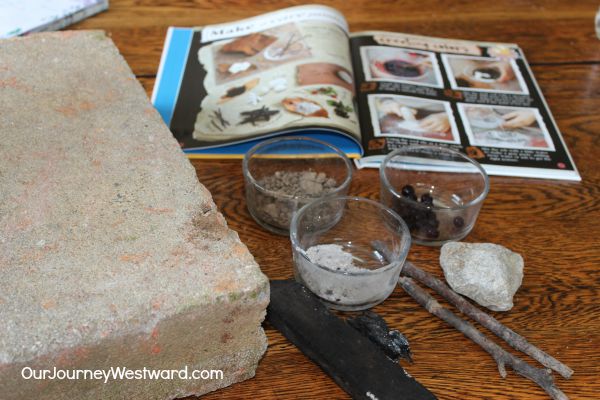
Ancient History Art Project: Cave Paintings
Fire, dirt, smashing berries, and smearing things—you can understand why an 8-year-old boy would find this project interesting. When I said it’s realistic, I meant it!
Gathering the supplies takes a bit of time and effort, but I promise you won’t regret it. Even better, you can also count the gathering of supplies as nature study for the day! We deviated just a bit from the suggested materials, but the results were very much the same as illustrated in My Art Book from DK Publishing.
Supplies to Gather for the Project
- a concrete block
- charcoal, burned sticks, and ash from a recent fire
- soil
- blueberries, cherries, blackberries, or another highly pigmented, crushable fruit
- sticks for stirring
- painting tools like sticks, rocks, and plants
- a pourable container of water
- Crisco
- a few small bowls
Directions for Creating the Natural Art Supplies
Once you’ve gathered the basic supplies, there’s still work to do. Don’t worry; this part is just as fun as collecting the supplies.
Artists, even ancient artists, need art supplies. As an ancient artist, you must make some natural paints and drawing tools.
Fruit Pigment Paint
In one bowl, add a few tablespoons of colorful fruit. We thawed frozen blueberries, but you are free to use any berry or fruit with plenty of bright pigment. Consider cherries, blackberries, strawberries, or even beetroot. Use a stick to smash it all together to create a natural dye for painting. Add enough water to make a paint-like consistency.
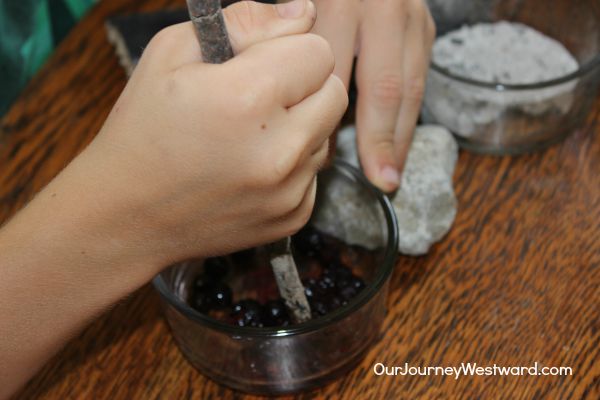
Ash Pigment Paint
In another bowl, stir a little water into a few tablespoons of ash. Be careful not to breathe the ashes! We found our ashes in our outdoor fire pit. Again, you will want the consistency to be paint-like, not too runny but not so thick you can’t spread it.
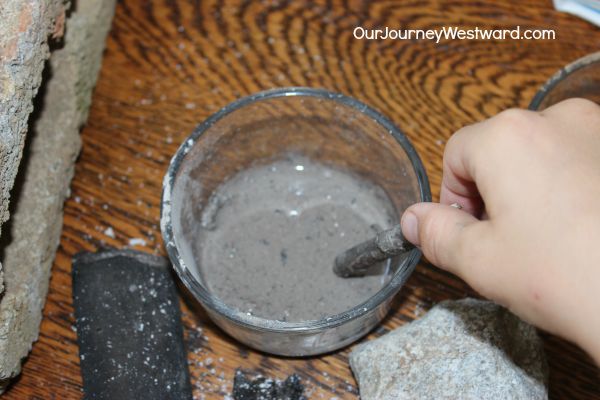
Dirt Pigment Paint
In another bowl, stir a tablespoon of fat (Crisco) into a few tablespoons of dirt. This creates an entirely different type of paint that is fun to compare to the water-based ones you’ve already created.
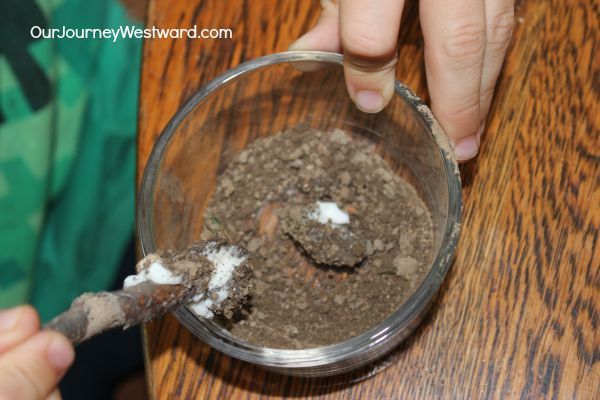
Firepit Drawing Tools
If you have a firepit, gather a few charcoal pieces and/or a burnt stick for drawing. You can also use black chalk instead.
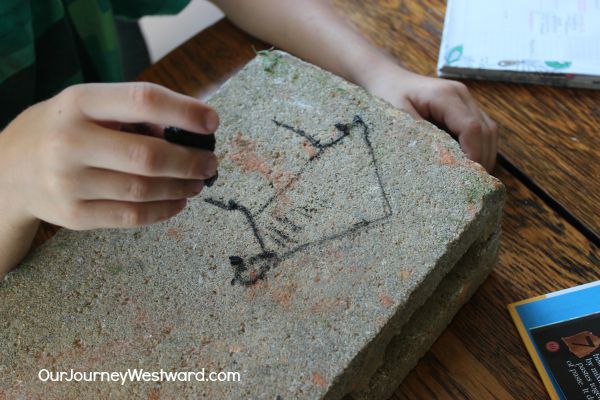
How to Create the Cave Art
Ancient cave artists used fingers, sticks, rocks, rawhide, brushes made from animal hair, and even plants as painting utensils. Of course, they also used burnt sticks as writing utensils.
Use your fingers and other imaginative natural tools to paint and draw a scene on your concrete block using the pigments you made and the writing utensils you collected. It may be helpful to look up some actual pictures of cave art before you begin so your cave art can be as realistic as possible.
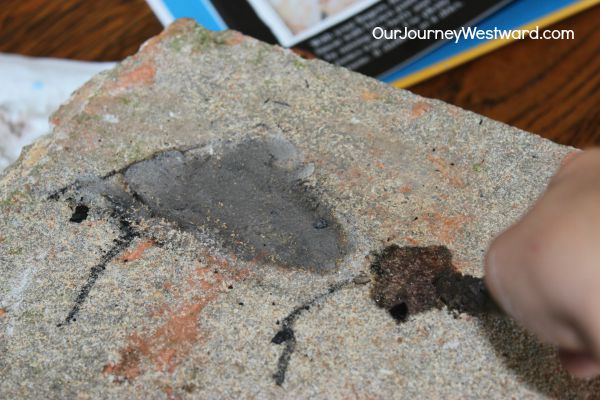
And that’s it! After some research, drawing, and painting, you have a FUN and very cool finished project.
The use of realistic materials is what makes this project such a powerful experience. After reading about the importance of archaeologists in understanding the lives of ancient people and learning that cave dwellers painted pictures that depicted their daily lives, doing such a realistic project helped Eli “get” the importance of both the artists and the archaeologists. I’m so thankful for Story of the World and My Art Book!
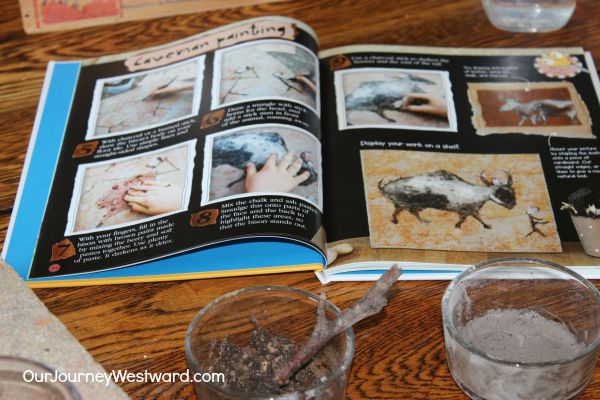
I LOVE that the entire project was illustrated step-by-step with clear directions for my son to follow independently. We’re working on learning independence more this year, and the lesson was perfect for him!
I can’t wait to share more from our ancient history studies this year. If you have a “knock it out of the park” type of project you would suggest during our study, please share it in the comments!
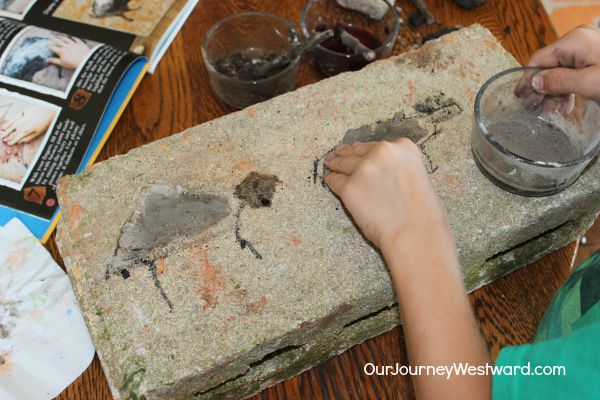
Other posts you might like:
Products you might like:
-

-
 Animal Signs$28.00
Animal Signs$28.00 -
 Ever-changing Erosion$28.00
Ever-changing Erosion$28.00




Awesome! He did a great job. It truly does look ancient. I will try this with my youngest.
I really want to do this! My kids would love it. 🙂
Love this Cindy, we’re doing Ancients this year too, it’ll be my 4th time through Story of the World, and I too love this book/program for a history spine. Hoping to incorporate your cave painting ideas in 🙂 I’m also using Barb Harmonies Ancients Music and Art for the year, it’s great! Enjoy your new year! xo
Do you think you could use this with paper bags as the back drop?
Sure, Patricia! I think that would work just fine. Let me know how it goes!